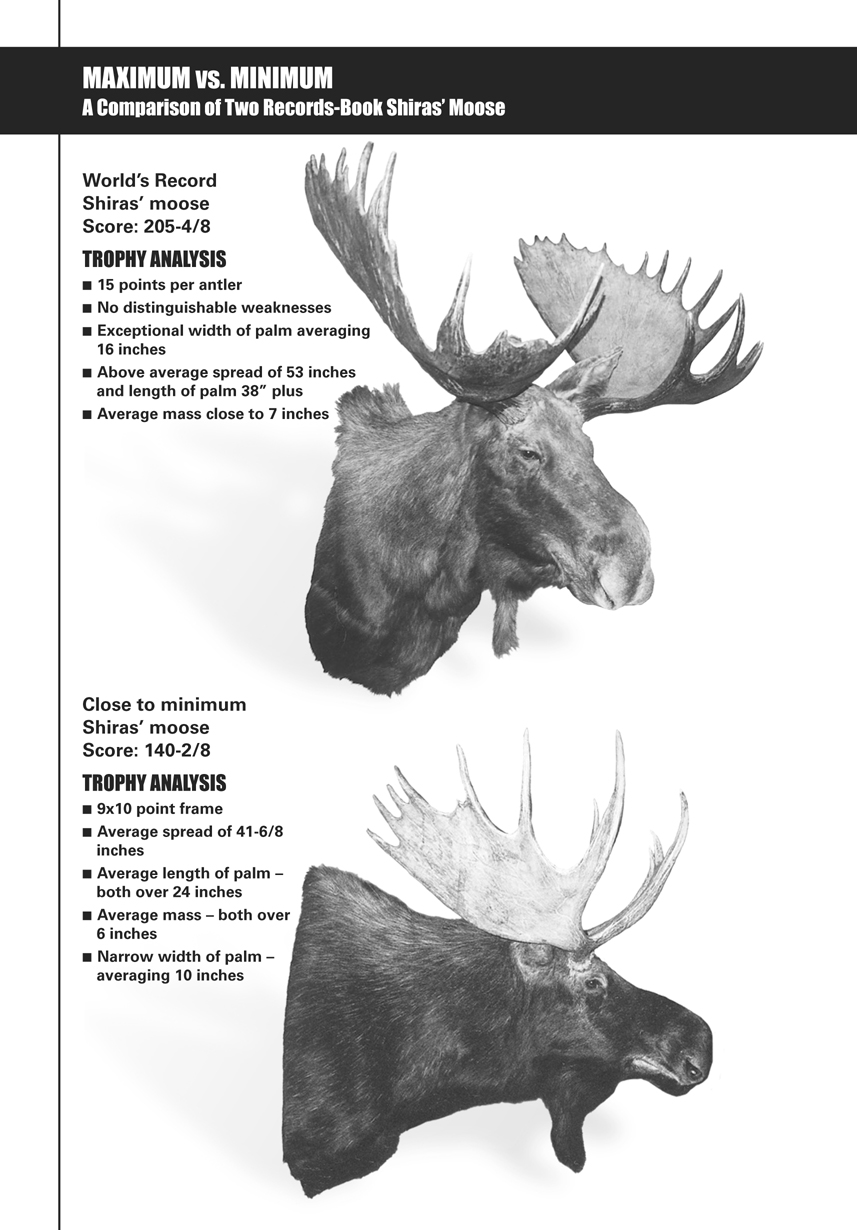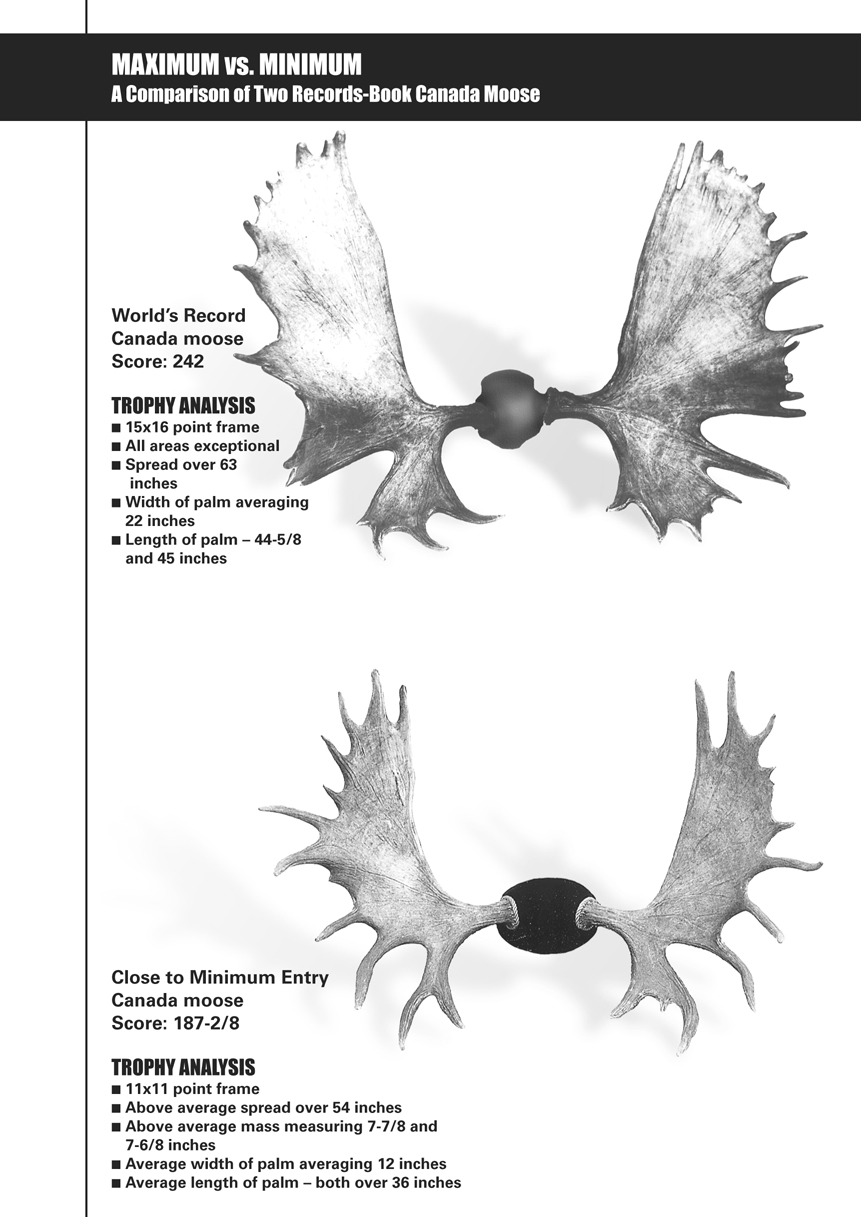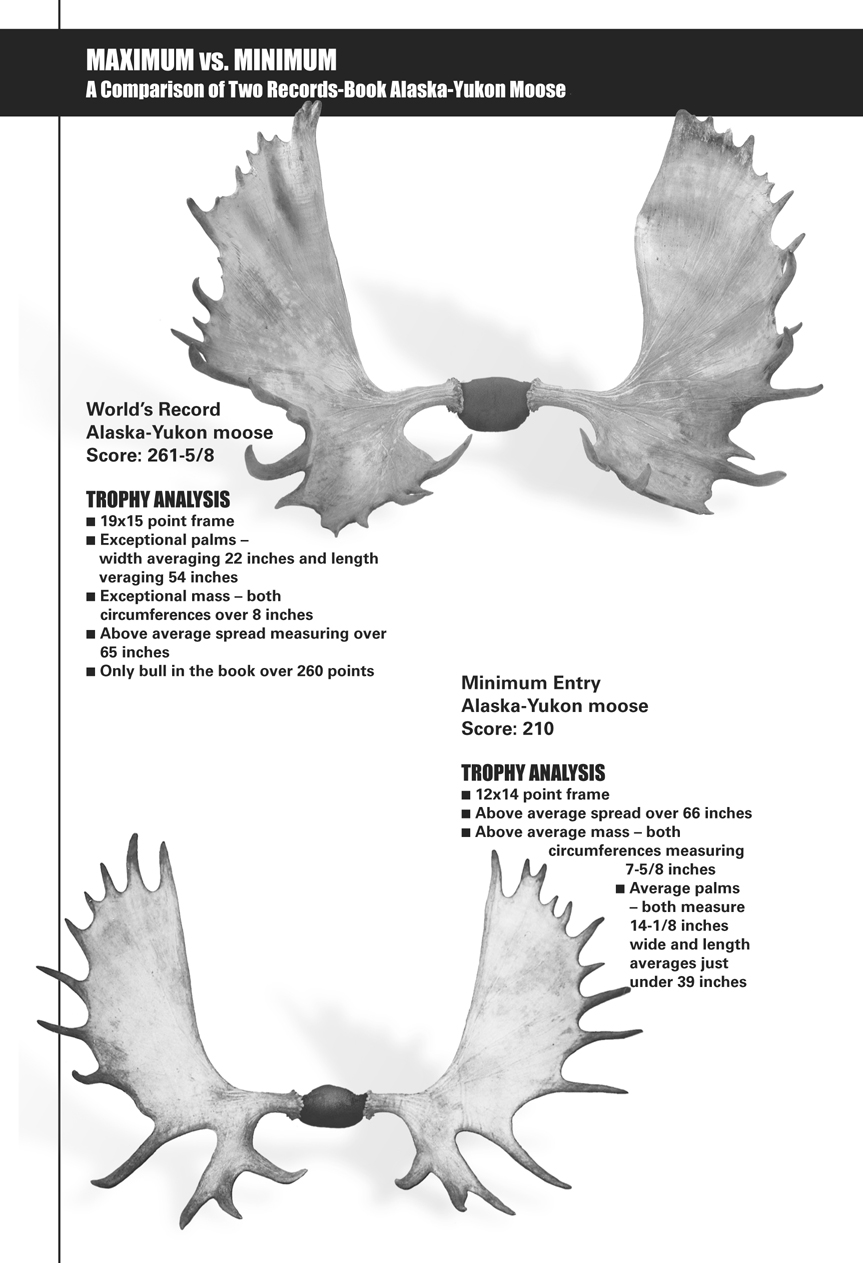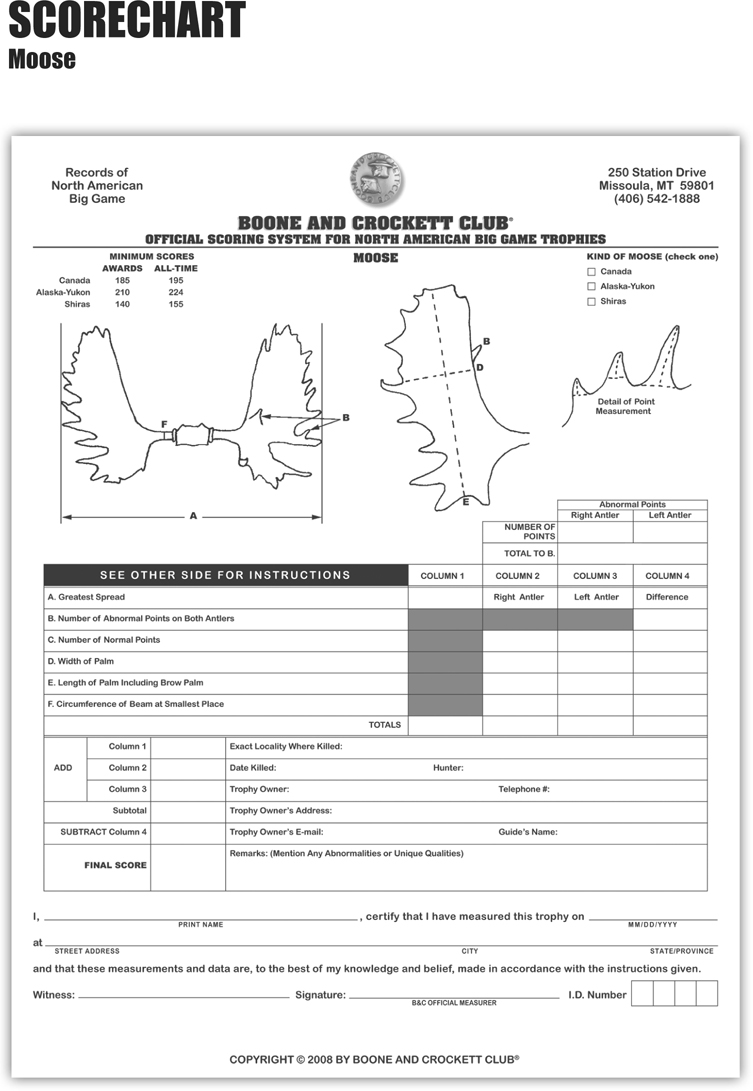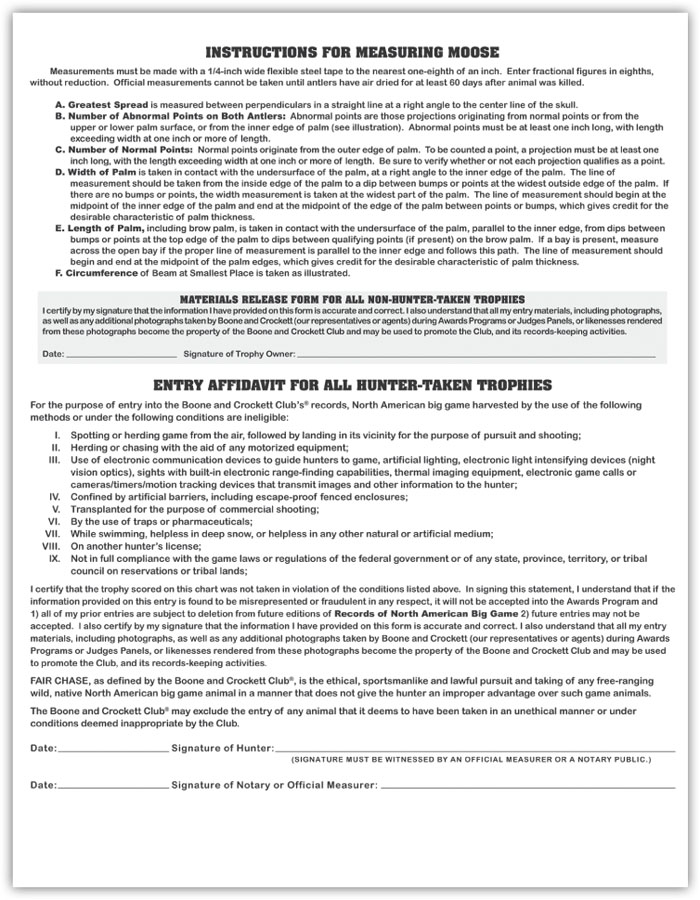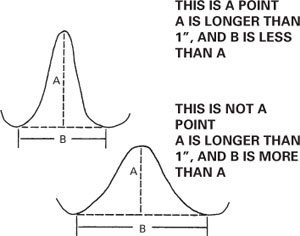
As detailed in the section on geographic boundaries, there are three categories of North American moose recognized for entry in the Boone and Crockett Club’s Awards Programs. Alaska-Yukon moose are the largest bodied and heaviest antlered; Shiras’ moose are the lightest; Canada moose are intermediate in both respects. Fewer measurements are taken for moose than for the other antlered categories. Despite this, moose can be one of the most complex trophies to measure.
In the past, moose with skull plates that had been fractured or shattered by a bullet, dropping, etc., were not acceptable for entry in B&C. However, it is now possible to enter such trophies, so long as the pieces can be perfectly pieced back together and the spread measurements taken. Skull plates that have been sawn in half still are not eligible for entry in B&C. Each damaged skull is considered on a case by case basis. See the Shed Antlers/Split Skulls policy for complete details of this policy.

Rather than having their length measured, points on moose antlers are simply counted. The reason point lengths are not recorded is that moose with well-developed palms with short points are considered more desirable trophies. Long points develop as a result of the lack of palm material. Including point length measurements would thus discriminate against the more desirable character of well-developed palms.
In moose, a point is any projection at least one inch long and with a width, at the point of measurement at one inch or more from the tip, less than the length (figure 8-A). The length determination of a moose point is a straight-line measurement without wrapping the tape to the center of the projection. If necessary, projections should actually be “carded.” Point width is taken perpendicular to the axis of the point as figure 8-B shows.

Normal points arise only from the outer edge of a palm. Abnormal points are not common on moose racks. Any point that grows from the palm face on the front or back surface, or on the inside edge of the palm, or on any other unusual location is regarded as abnormal. Sometimes moose will have double palmation on one or both sides. Any points projecting from the secondary, abnormal palm must be treated as abnormal points as well. Show the count of such points in the box on the upper right side of the score chart and enter the total count into the abnormal point total on the score chart line B where it will be a deduction from the score. There is no requirement that antler points must be matched with corresponding points on the opposite antler to be regarded as normal. But, points on moose antlers are best rewarded if there are an equal number of normal points on each side. Record the appropriate point count for each antler on line C of the score chart.
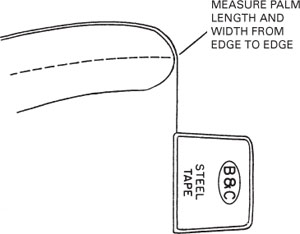
There is a tendency for Measurers to count every major projection on a moose antler as a point. When moose antlers are remeasured at panel judging sessions, the biggest discrepancy in scores arises from incorrect, initial point counts. Many projections on moose antlers appear to be points when in fact they are not as the width of the point remains greater than the length at all points of measurement. Such projections do not meet the definition of a point and, thus, are not to be included in the point count. The only way to tell if all projections qualify as a point is to measure each one.
After determination of and recording of the number of points present, the length of palm measurements are taken. In taking both length and width of palm measurements, the start and finish of the measurement lines should be the midpoints of the edge of the palm. This approach recognizes the thickness of the palm material, a desirable characteristic, as part of the measurements. Figure 8-C illustrates this approach.
To begin the length of palm measurement, turn the rack upside down and lay out a strip of masking tape parallel to the inside edge of the palm. Then consider alternative ways the length of palm could be measured so that the measuring tape will remain parallel to the inner edge line established by the masking tape. In moose with well developed lower palms and top structure, there may be several possible measurement lines. It is helpful to lay out possible lines with masking tape (even if there is only one possibility). These alternate masking tape lines provide visual reference for the comparison of possibilities. See figure 8-D for an illustration.
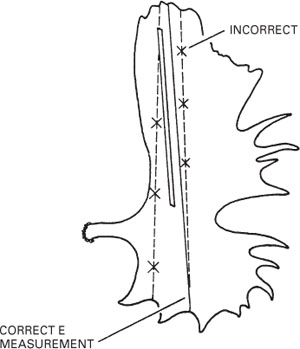
The correct length of palm measurement is the longest line that can be measured in contact with the antler surface that is also the most parallel to the inside edge of the palm. Typically this line will extend from the bottom of a dip on the palm top to the bottom of the valley between points on the brow. Since many large moose racks do not have any countable points on the palm top, the line can be started from any dip (notch) or indentation along the top edge. This line can never be taken from the tip of a point.
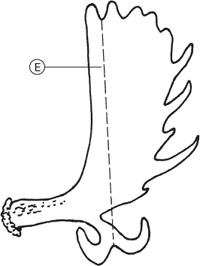
Often the length line crosses an open bay on the outer edge of the palm. This is acceptable as long as the line is the longest, most parallel line (figure 8-E). However, the line can never pass over open space on the inner edge of the palm as figure 8-F shows.
If the brow is palmated with several points, the line extends from the top of the upper palm to the bottom edge between points. If the brow is forked and without other points, the line should extend to the bottom of the fork. Unlike the beginning of the length measurement on the top of the palm, the end of the measurement on the lower edge must always be between points (if present), not simply to dips or indentations along the lower, brow palm.
If the brow is not forked, and is really only a spike extending forward, the edge of the main palm then becomes the termination of the palm length measurement line. Figure 8-G shows this situation. The proper length line on moose with a spike as the brow palm is the longest parallel line to the inner edge that does not cross an open bay on the outer palm edge.
The correct length of palm measurement for an antler where the entire top of the palm is completely broken off with no clearly defined points or bumps remaining on the top of the palm is a line parallel to the inside edge of the palm in contact with the undersurface of the antler. Start by using masking tape to establish a line parallel to the inner edge of the palm. The length then starts at the bottom of a dip between qualifying points on the brow palm and extends to the midpoint of the upper edge of the broken top palm. If there is more than one option for taking the length of palm measurement, because of multiple dips between points on the brow palm, the longest length parallel to the inner edge of the palm is taken and recorded.
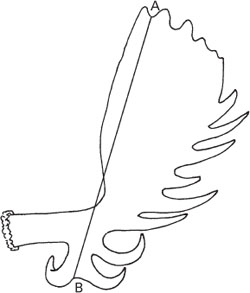
Once the palm length has been properly established, the palm width can be taken. Palm width is taken at a right angle to the inner edge of the palm. Use the masking tape line that was initially established as the line parallel to the inner edge of the palm as the reference line for this measurement. The line of measurement is taken in contact with the palm’s under (back) surface (this will be the “upper” surface if antlers are turned upside-down as previously instructed). The width measurement starts at the midpoint of the inside edge of the palm and extends to the midpoint of a dip between points or bumps at the widest outside edge of the palm. If there are no points or bumps, the width measurement is taken at the widest part of the palm.
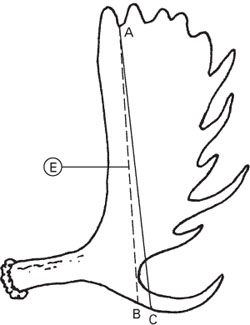
There may be some question as to how far down the top palm this measurement may be taken. The width may be recorded as far down the top palm as the upper edge of the horizontal plane of the main beam. Palm width cannot be taken on brow palm
A single circumference of each main beam is measured by looping a ring-end tape around the beam, with the zero mark up. Pull the tape together and gently move it along the beam until the smallest circumference measurement is obtained. If you use a clip-end tape to measure circumferences, overlap the tape at a full 10-inch increment to simplify the procedure. Be sure to subtract the amount of overlap before recording the measurement.
The greatest spread is best determined by use of two perpendiculars (such as carpenter’s levels supported upright by large c-clamps), or by use of a floor and wall (providing it is a true 90 degree angle) for one perpendicular and a carpenter’s level held upright by a large c-clamp, or a carpenter’s square for the other. When the perpendiculars have been properly established against the rack, the greatest spread is measured between them in a straight line, at a right angle to the skull center line, by using the folding carpenter’s rule. Usually, the antlers and attached skull are turned upside-down, resting on a level floor, for this measurement. Obviously, care must be taken that the line of measurement is at a right angle to the center line of the skull to ensure the measurement is not improperly at a diagonal. Unlike other antlered species, the greatest spread for a moose is directly part of the final score.
The greatest spread cannot include any portion of an abnormal point. If an abnormal point impacts the greatest spread measurement, find the greatest spread that does not include the abnormality. Note this action in the REMARKS section of the score chart. The greatest spread can occur across the brow palms as well as across the top palm. In fact, the point of contact on one side for greatest spread may be at the tip of a point along the outer edge of the top palm and on the edge of the brow palm on the other as long the measurement line remains square to the center line of the skull.
Rarely, a moose palm will show ridges and valleys or even a highly corrugated, folded surface of palm. In such a case, it would not be fair to simply measure the length and width of palm in the usual fashion. If the ridges and/or corrugations were “ironed-out,” the palm would be either longer or wider, or both. The solution for this condition is establishment of the usual lines of measurement but with the actual measurement taken by following the edge of heavy, craft-like paper, cut perfectly straight, that is laid across the ridges and into the valleys. The paper is forced into the valleys to properly contact surface material of the palm along the entire line of measurement. The number and location of the corrugations or valleys can obviously alter the placement of the measurement lines. Trial-and-error measurements must be used in such cases, keeping in mind the correct location of length and width measurement lines in relation to the inner edge of the palm.
The total mass of antler material of a large Alaska-Yukon moose is greater than that of any other living member of the deer family. Alaska-Yukon moose racks may exceed 60 pounds when fully dried. Large Canada moose racks may weigh in excess of 50 pounds and Shiras’ moose antlers may weigh more than 30 pounds. Information on rack weight is requested as supplemental information on the back of the Hunter, Guide and Hunt Information form.
Of all the living members of the deer family, moose have the greatest amount of antler material. They also show great variation in size, with the smallest racks coming from Idaho, Montana, Utah and Wyoming, and the largest from Alaska, Yukon, and the Northwest Territories. A records book sized Shiras moose would not be even a desirable trophy in Alaska.
Although the widest spread antlers are sought in all categories for the records, strong development of antler palmation in both length and width is even more desirable. Many Shiras moose show only a single spike brow point on each antler, rather than a well-developed brow palm. This is undesirable since the length-of-palm is measured to a notch between brow points. The single spike brow dictates that the length of palm measurement must be ended at the edge of the main palm, obviously losing some potential that would have been fulfilled if the brow were palmate or even forked. High-scoring Canada or Alaska-Yukon moose have three or more brow points, on broad, well-developed brow palms that increase the length-of-palm measurement. This feature, along with broad main palms, markedly improves the score potential.
Although an Alaska-Yukon moose may have 15 or more points on each antler, not all projections count as points, especially if they are blunt in shape. One cannot accurately count the antler points on most trophy moose when the animal is in the field, so evaluation must generally be made on the basis of the amount of palm material present and the greatest spread.
Big trophy moose of all three classes tend to have the main palms lying flat to produce a wide spread, whereas smaller antlers are more apt to show cup-shaped palms and a narrow spread. Even though moose can often be studied carefully in the field, and an experienced guide may make reasonable estimate of the greatest spread, it is very difficult to estimate the scores accurately at a distance. This is because the length, width, and symmetry of the palms are all hard to judge when seen from the side. A frontal view, with the animal’s head down and antlers nearly vertical, gives a much better chance for accurate evaluation, but may not be available under field conditions. ■
